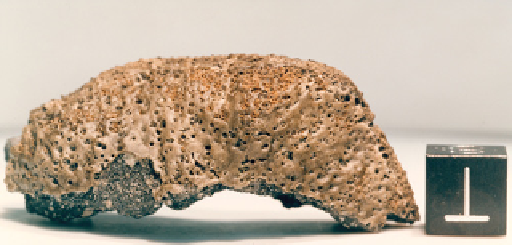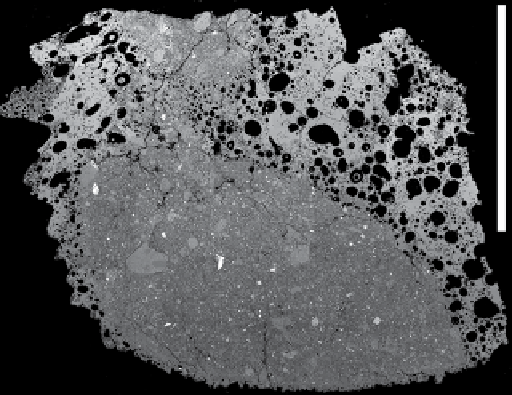Geology Reference
In-Depth Information
1995] are highly immature. QUE 93069 was formed from
submature regolith (
I
S
/FeO = 34) [
Lindstrom et al
., 1995].
Fusion crusts of nearly all stony meteorites are
vesicular from release of gases at the surface of the
meteorite during atmospheric entry [
Genge and Grady
,
1999]. A prominent characteristic of several ANSMET
lunar regolith breccias is the presence of thick and
highly vesicular fusion crusts. These vesicular crusts are
most apparent on those meteorites that have high abun-
dances of gaseous solar wind-implanted elements (e.g.,
H, He, N, Ne, Ar), most notably ALH A81005, QUE
93069/94269 (Figure 6.5), QUE 94281, and PCA 02007
(Figure 6.6). (Vesicular fusion crusts are seldom seen
on hot-desert meteorites because the crusts on those
meteorites have largely been eroded away by dust-bear-
ing wind.) As
Thaisen and Taylor
[2009] warn, however,
unbrecciated, basaltic lunar meteorites LAP 02005 and
MIL 05035 also have vesicular fusion crusts, and these
are not likely due to solar wind-implanted gases.
Nevertheless, it is among the regolith-breccia meteor-
ites where thick, vesicular fusion crusts are most
evident.
QUE93069,0
Figure 6.5.
The thick, vesicular fusion crust on regolith breccia
QUE 93069. The cube is 1 cm in dimension. NASA photo.
6.4. COMPOSITIONAL SYSTEMATICS
To a good first approximation, compositions of poly-
mict lunar samples (breccias and regolith) can be mod-
eled as mixtures of three classes of material [
Korotev
,
2005;
Lucey et al
., 2006]: rocks of the Feldspathic
Highlands Terrane [
Jolliff et al
., 2000], rocks of the
Procellarum KREEP Terrane [
Jolliff et al
., 2000], and
rocks (and pyroclastic glass beads) from the basaltic
maria, which occur in both terranes. Rocks of the
Feldspathic Highlands Terrane (Figure 6.2) are mainly
anorthosites, noritic anorthosites, troctolitic anortho-
sites, and their brecciated derivatives. They are character-
ized by low concentrations of elements associated with
mafic minerals (e.g., Fe and Sc; Figures 6.3 and 6.4), high
concentrations of Al
2
O
3
and CaO (Figure 6.7), and low
concentrations of incompatible elements (e.g., Sm and
Th; Figures 6.3 and 6.4). Materials of the Procellarum
KREEP Terrane are typically noritic in composition,
with intermediate concentrations of FeO and Al
2
O
3
but
high concentrations of incompatible elements. Rocks and
glass from the basaltic maria are rich in FeO and Sc but
poor in Al
2
O
3
, with low to intermediate concentrations of
incompatible elements. This
Apollo
view of lunar meteor-
ites may be oversimplified in that some lunar meteorites
of intermediate FeO concentration (Figure 6.4) may not
be mixtures of feldspathic material and mare basalt.
Rather, they may represent mixtures that include moder-
ately mafic material of the Feldspathic Highlands Terrane
unlike that sampled by the
Apollo
missions [
Korotev et al
.,
2009b].
Figure 6.6.
BSE (backscattered electron) image of a thin sec-
tion of PCA 02007, a regolith breccia. At the top of the image
is the thick, vesicular fusion crust caused largely by release,
during atmospheric entry, of gases implanted by the solar
wind while the material of the meteorite was fine-grained reg-
olith on the lunar surface. The lower part of the image shows
typical regolith-breccia texture. In BSE images, brightness
increases with mean atomic mass. The darkest areas are rich in
plagioclase (Al) and the lightest areas are rich in mafic
(Fe-bearing) minerals.
concentration of siderophile elements like Ni and Ir,
which are mainly derived from impacts of micrometeor-
ites, and increase in the magnitude of the ferromagnetic
resonance parameter
I
S
/FeO [
McKay et al
., 1974, 1986;
Morris
, 1978;
Korotev et al
., 2006]. Most samples of reg-
olith fines collected on the
Apollo
missions are submature
(30 <
I
S
/FeO < 59) or mature (
I
S
/FeO ≥ 60) [
Morris
, 1978).
Most regolith breccias from
Apollo
15 and 16, however,
are immature (
I
S
/FeO < 29) [
McKay et al
., 1986].
Unfortunately,
I
S
/FeO has been measured on only three
lunar meteorites. ALH A81005 (
I
S
/FeO = 5) [
Morris
,
1983] and MAC 88105 (
I
S
/FeO = 0.8) [
Lindstrom et al
.,


